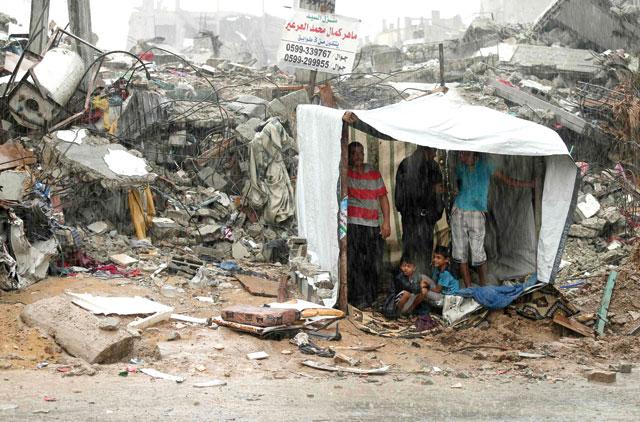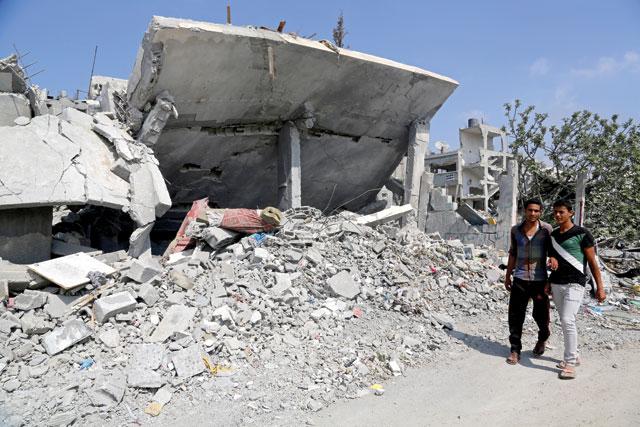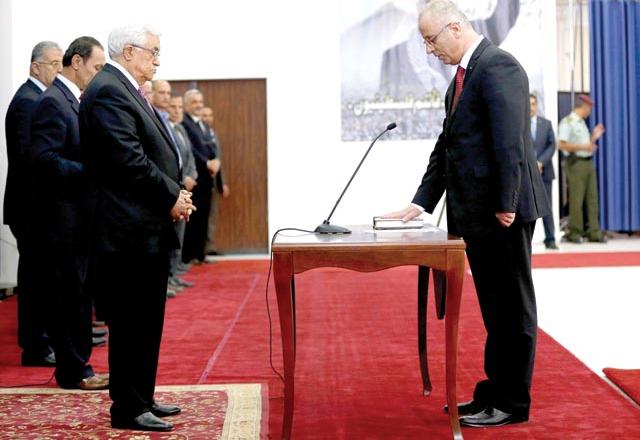You are here
Palestinians downbeat on promised rebuilding of ruined Gaza Strip
By Reuters - Oct 21,2014 - Last updated at Oct 21,2014

GAZA/RAMALLAH, West Bank — The first torrential downpour of an approaching winter has already soaked the Gaza Strip, compounding the misery of thousands of Palestinians who scrambled to patch homes wrecked by the summer war with Israel.
While Palestinian officials rejoiced at $5.4 billion pledged at an international aid conference last week towards reconstruction and shoring up their budget, many in Gaza fear that, as was the case after past wars with Israel, not all the money will materialise.
No one disputes the need is urgent: the United Nations says 18,000 dwellings were destroyed or damaged in 50 days of fighting between Israel and Palestinian fighters, and 108,000 people are homeless in a long impoverished, isolated territory.
The flow of building material and other aid will largely depend on whether the Western-backed Palestinian Authority (PA) that exercises limited self-rule in the Israeli-occupied West Bank extends its writ to Gaza, now run by the Hamas Islamist group shunned by many countries as a designated terrorist group.
But despite a Palestinian unity deal in April, Hamas and its political rivals still bicker. Local businessmen say a mechanism agreed by the United Nations, Israel and the Palestinians for construction materials to move from the West Bank across Israeli territory to Gaza remains vague and plagued by red tape.
Any help could not come soon enough for Samir Hassanein, 37. A gaping hole in his damaged home exposes his sitting room to the elements, despite desperate efforts to shield it with plastic sheeting and bricks.
His neighbourhood of Shejaiya was shredded by Israeli artillery fire on July 20. For almost two months, Hassanein and his family have stayed on; he was eager not to stray far and miss delegations from the UN and charity organisations to register his house for repair funds that have yet to come.
“They must build our houses for us — we can’t live like this. They should have begun building long ago. We’re not ready for winter and now we’re drowning in the rain,” he told Reuters.
Israel heavily bombarded and partially invaded Gaza, a small coastal enclave with a 1.8 million population, while Hamas peppered Israeli cities with rocket fire during seven weeks of combat. It killed over 2,000 Palestinians, mostly civilians, and more than 70 Israelis, almost all of them soldiers.
Densely populated border areas like Shejaiya were almost completely razed when Israel took them over and destroyed tunnels there which Gaza fighters used to attack into its territory.
Since the aid conference in the Egyptian capital Cairo concluded on October 12, only 75 truckloads of building materials have entered Gaza through Israel — on one day last week.
Gaza economic analyst Maher Al Tabbaa said the amount is under a fifth of the daily import volume required if war damage is to be repaired in three to five years.
Despite the formation of a Palestinian unity government of technocrats in June, an enduring schism between Hamas, which led the Palestinian war effort, and the moderate Fateh Party in the West Bank casts doubt on whether the traffic flow will improve.
Hamas — which unlike Fateh rejects negotiations to achieve a Palestinian state in territories Israel captured in a 1967 war — seized Gaza from the Fateh-led PA in a brief civil war in 2007. Hamas had won a Palestinian parliamentary election in 2006, a year after Israel pulled its soldiers and settlers out of Gaza.
Israel has imposed a strict blockade on Gaza since the Hamas takeover, saying it seeks to restrict goods that could be used in weapons production and underground tunnels. But this has worsened economic hardship in the dilapidated, arid territory, where more than half of the population receive UN food aid.
An agreement last month for Hamas to hand over control of border crossings to its Western-supported Palestinian rivals might allay Israeli and donor fears that the group could siphon off or profit from reconstruction aid.
“The money pledged represented a ray of hope and if... the crossings were opened and there were an honest implementation of the reconciliation between Fateh and Hamas, international donors would be encouraged to give more money because what had been pledged was not enough,” economic analyst Al Tabbaa said.
Hamas blames the West Bank-based unity government for not assuming responsibility for the two border crossings yet and ferrying in building supplies.
But at the same time, Hamas’ official magazine boasted on Sunday that fighters were working “like bees in their hives” to rebuild their tunnels, a major consumer of concrete and steel.
Palestinian officials have put the cost of physical rebuilding at $4 billion. But donors allotted only around $2.7 billion towards it, and the other half of its pledges for the cash-strapped PA budget.
The economic picture in the West Bank is also depressed.
Between 2007 and 2011, growth soared at an annual average 8 per cent. But a steep drop in donor support, especially from Arab neighbours, and the devastation in Gaza will lead to a slump in 2014 to 0.5 per cent in the West Bank and a contraction of 15 per cent in Gaza, the World Bank forecast last month.
Palestinian Prime Minister Rami Hamdallah said last week that while Gaza’s need was immediate and plans were ready, work could not begin in earnest on pledges alone. “It was our previous experience in Sharm El Sheikh in 2009 that most of the money did not come,” he said, referring to an Egyptian-led conference after a December 2008 — January 2009 Gaza war.
Donors have backed Palestinian efforts to build an economy capable of statehood in the West Bank despite Israeli restrictions on the free movement of goods and people there, and hope the unity pact will help buoy Gaza’s shattered fortunes.
“Until now this progress has been limited more or less to the West Bank. Now I think the time has come to extend this work to Gaza. We are aware of the obstacles, including political and economic constraints, but this will not prevent us from supporting the PA,” European Union regional representative John Gatt-Rutter said last week.
While the EU has remained one of the PA’s most reliable donors, Palestinians may face acute funding problems if they make good on a pledge, given the breakdown in peace talks in April, to seek full statehood at the UN Security Council soon.
Palestinian sources say the United States, has threatened to dock the roughly $500 million it gives annually to the West Bank government’s budget and security forces.
Israel would likely also withhold the $100 million in customs duties it shifts monthly to the Palestinian Authority, a sum that makes up about a third of the PA’s revenue.
Red tape
Analysts and officials have also cast doubt on the efficiency of a mechanism to monitor and license Palestinian construction companies agreed by the PA, UN and Israel.
They say Gazans whose homes were damaged or destroyed will register with the United Nations, which will then transfer their claims to Israel for approval of the required amount of construction material. The Palestinian private sector will then apply to import the allotted building materials, which if approved, will be funded in installments.
Companies must also maintain round-the-clock cameras on their storage to prove fighters have no access — a tall order in Gaza, where there are only six hours of electricity per day after Israeli shells knocked out the main power plant.
Ibrahim Barhum, head of the Palestinian Coordinating Council for the Private Sector, attended the Cairo conference and urged participants to cut back bureaucracy in the way of aid.
“The people of Gaza are in a tragic situation and winter has begun,” he said. “We’re talking three to 10 years, and this is something the people of Gaza won’t accept and can’t bear.”
Related Articles
Envoys from dozens of countries will gather Sunday for a conference that aims to raise billions of dollars to rebuild conflict-battered Gaza, despite fears of renewed violence and "donor fatigue".
Three months after the war in Gaza, Sadeeqa Naseer still lives in a bomb site. Air strikes turned the two upper floors of her three-storey apartment building in the Gaza Strip town of Beit Hanoun into a rubble-strewn ruin.
President Mahmoud Abbas swore in a Palestinian unity government on Monday in a reconciliation deal with Hamas Islamists that led Israel to freeze US-brokered peace talks.



















